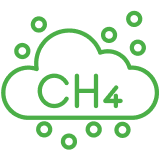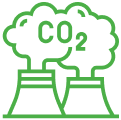
THE IMPORTANCE OF REDUCING SLCPs
Why reducing SLCPs matter?
Reducing short-lived climate pollutants (SLCPs) is essential for limiting near-term climate warming due to their high Global Warming Potential (GWP) and strong radiative forcing. Unlike CO₂, SLCPs respond quickly to mitigation, offering immediate climate benefits. Their reduction can significantly lower the rate of Arctic ice melt, sea-level rise, and extreme weather events. Controlling SLCPs also improves air quality by reducing ground-level ozone and particulate matter. This dual benefit supports both climate stabilization and public health objectives.




Environmental Impact of SLCPs
Short-lived climate pollutants (SLCPs) cause rapid climate warming, reduce air quality, and place stress on ecosystems. Their high Global Warming Potentials and atmospheric reactivity lead to accelerated ice melt, reduced crop yields, and ecosystem degradation, particularly in sensitive regions like the Arctic and tropics.

Methane (CH4)
- Forms tropospheric ozone, harming crops and ecosystems
- Strong greenhouse gas with short-term warming impact
- Reduces atmospheric oxidation capacity

Black Carbon
- Lowers snow/ice albedo, speeding up melting
- Alters regional climate and precipitation patterns
- Influences cloud microphysics

Tropospheric Ozone (O3)
- Damages plant tissues and reduces yields
- Short-lived but potent climate forcer
- Harmful to human and animal respiratory health

Hydrofluorocarbons (HFCs)
- Very high global warming potential
- Rapidly increasing in use (e.g., cooling systems)
- No ozone depletion, but significant radiative impact
Health Impact of SLCPs
SLCPs contribute significantly to the global burden of disease by worsening air quality and driving climate-related health risks. Exposure to pollutants like black carbon, ozone, and methane-related byproducts leads to respiratory and cardiovascular illnesses, while warming-related impacts exacerbate heat stress, the spread of vector-borne diseases, and food insecurity.

Methane (CH₄)
- Indirectly affects health by increasing ground-level ozone, a respiratory irritant
- Contributes to climate-driven health risks like heatwaves and food shortages


Black Carbon (BC)
- Penetrates deep into lungs, causing asthma, bronchitis, and heart disease
- Particularly harmful to children, the elderly, and people with preexisting conditions


Tropospheric Ozone (O₃):
- Causes respiratory inflammation, reduced lung function, and aggravates asthma
- Linked to premature deaths from cardiovascular and pulmonary diseases


Hydrofluoro
carbons(HFCs)
- Low direct toxicity, but indirect health effects via contribution to global warming
- Increased temperatures can intensify health threats such as heat stress and disease spread

Impact of SLCP on Ecosystems, agriculture and biodiversity.
SLCPs disrupt ecological balance by altering climate, degrading air quality, and impairing critical biological functions. They reduce crop productivity, stress natural vegetation, and contribute to habitat degradation, threatening biodiversity and ecosystem services. Rapid climatic shifts driven by SLCPs can exceed species' adaptive capacities, leading to shifts in species distribution and loss of biodiversity.
Methane(CH₄)
- Enhances formation of tropospheric ozone, which reduces crop yields and inhibits plant growth
- Alters temperature and precipitation patterns, impacting ecosystem stability
Black Carbon(BC)
- Deposits on plant surfaces, reducing photosynthesis
- Contributes to glacial melt and downstream changes in water availability for ecosystems and agriculture
Tropospheric Ozone(O₃)
- Toxic to vegetation, leading to visible foliar damage, reduced growth, and lower crop productivity
- Disrupts nutrient cycling and weakens plant resilience, affecting food chains and ecosystem health
Hydrofluorocarbons(HFCs)
- Indirectly impact ecosystems through their strong warming effect
- Rising temperatures affect species ranges, breeding cycles, and increase stress on biodiversity hotspots


